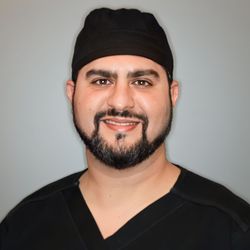Deciding to get dental implants isn’t a choice to take lightly. The investment in a new smile is something that will affect everything from your self-confidence and speech to your diet and facial profile.
How can you be sure that now is the best time to finally get dental implants? Here are some steps you’ll want to complete before investing in your treatment. Once you’ve worked your way through each of them, you’ll know that it’s a great opportunity to transform your smile.
Your Mouth is Fully Developed
It’s important that your oral anatomy is fully developed before dental implants are installed. For instance, if you are in your mid-teens and still have teeth that are growing in, it can change the alignment of other teeth in your mouth. Even the shape and size of the jawbone are things that need to be considered.
We don’t want to install dental implants in children because their mouths are still growing and teeth are erupting. Since implants are permanent, they could potentially cause a barrier to unerupted teeth.
The best dental implant candidate is someone whose mouth is nearly fully developed or their bones are no longer growing. So, while most of our clients tend to be in their 30s, 40s, and beyond, it’s also possible to install implants in older teens and college students who have missing teeth.
Once an implant is installed, we know it will essentially stay in that location for the remaining life of the patient. As such, we want to be sure that the oral anatomy and surrounding facial features are nearly fully developed before an implant is placed. Otherwise, you could potentially wind up with a “tooth” that seems out of place when compared to the other teeth in your mouth.
Adults of all ages are great candidates for dental implants. It’s not uncommon to see patients who are well past their retirement or active grandparents, who finally want to invest in a permanent alternative to dentures and partials. You’re never “too old” to get dental implants. In reality, it’s usually because someone is still “too young.” Fortunately, our implant specialist can monitor your child or teen to determine the earliest window where a dental implant is safe to place.
You’re About to Have Teeth Extracted
Do you need to have some of your teeth removed? Perhaps they have aggressive periodontal disease, tooth decay, or traumatic damage that makes them non-restorable. While it’s usually a dentist’s top priority to preserve natural teeth whenever possible, that’s not always going to be doable. Instead, a therapeutic—or even an emergency—tooth extraction is the best way to get your smile’s health back under control
But removing teeth creates extra space in your bite, which can lead to adjacent teeth starting to shift out of alignment. Losing one or two teeth is enough to throw off the balance of your entire smile. So, if you know you’re about to have teeth extracted, the best thing to do is make a plan to replace them as soon after the removal as possible.
Depending on the health status of your mouth, it might be possible to install or initiate your dental implant treatment on the same day that teeth are extracted. If not, your implant specialist can still begin to “prep” that part of your mouth to receive a dental implant a short time thereafter. Such as place a bone graft to strengthen the jaw.
If tooth extractions are inevitable, you need to have a game plan for replacing your missing teeth as quickly as possible. And dental implants are an excellent solution. There are even options available to have a temporary prosthesis made that you wear immediately following your extractions while the implants integrate (before they’re ready to receive a permanent fixture on top of them.) By planning ahead and working with our dental implant specialist, you’ll never have to worry about someone else seeing you with missing teeth.
You Already Have Missing Teeth
Dental implants are one of the best—if not the ultimate—choices when it comes to replacing missing teeth. If your teeth have already been missing for quite some time, you might qualify for dental implants.
Are you already wearing a removable partial or full denture? Dental implants are still an option. Many people choose to upgrade their prostheses to something permanently fixed so that they don’t have to worry about it rocking or slipping out of place. Maybe you decided to wear dentures for a while and then save up for dental implants at a later point.
No matter how long your teeth have been missing, whether it’s 20 months or 20 years, you can still consider getting dental implants. Even older bridges where the supporting teeth are giving out can be replaced with a fixed implant option on a case-by-case basis.
If you chose a different type of tooth replacement but want to get dental implants in the future, you usually can. Some of those decisions will depend on the type of restoration that you’re wearing and the health of the teeth on either side. But in the majority of cases, dental implants are not off the table.
Do you feel like you’re consistently “toughing it out” with your current tooth replacement option? There are other, better solutions out there. Just because you’ve made it this far does not mean you shouldn’t go ahead and upgrade to dental implants. Considering the fact that implants look and function nearly identical to natural teeth, investing in these fixed restorations can change almost every aspect of your day-to-day life.
Your Gums are Healthy
One of the most important qualifications for getting dental implants is having healthy gums. If your gums are infected, swollen, or bleed easily, those issues will need to be addressed before dental implants can be installed. Why? Because periodontal infections—meaning gum disease—are the leading risk factor when it comes to the failure of a dental implant.
The implant form of gum disease is called “peri-implantitis” (instead of periodontitis.) It involves inflamed and bleeding gums around the dental implant. When those infections are present, it prevents the gum and underlying bone from forming a tight seal or bond around the surface of the implant. Ultimately, it becomes a matter of time before the bone detaches from the implant and the restoration starts to loosen or fall out.
If you’ve had periodontal disease in the past, now is the time to seriously consider whether or not it’s a good idea to get dental implants. Fortunately, gum disease can be treated and managed well enough that even if you used to have an infection, you can still get dental implants. But if you have an active oral infection right this moment, it’s not safe to install dental implants. Those areas of gum infection will need to be addressed before the next steps can be taken in your smile rehabilitation.
Fortunately, our doctors at PCE are an expert when it comes to managing chronic periodontal disease. As a gum specialist, he’s able to work with individuals who have experienced extensive gum disease and guide them through the oral rehabilitation process. So even if you’re worried that your bleeding gums may prevent you from getting dental implants, our doctors at PCE can help you get your dental concerns under control again.
Existing Dental Disease is Under Control
Do you have any active cavities, broken teeth, or dental work that needs to be completed? Those issues will need to be addressed first, before moving forward with dental implant treatment.
You might ask, “Why do I need to treat a cavity on the other side of my mouth if that’s not even where the dental implant is going to be?” Great question! Ultimately it boils down to the presence of “bad” bacteria and infection inside of your mouth. Tooth decay is a bacterial infection that, given the chance, will continue to spread into adjacent teeth and throughout the mouth. While the issue may seem small, it needs to be addressed as quickly as possible. The last thing we want to do is invest in something significant like a dental implant when we know there’s an unhealthy tooth somewhere else inside your mouth.
Cavities and cracked teeth can affect the way your teeth bite together, as well as chewing patterns. If we were to install a dental implant now and then later on you restored those teeth with crowns or fillings, there’s a possibility that your teeth might not function the same way they did beforehand. You could find that your overall chewing pattern shifts, changing the way your implant bites against other teeth in your mouth.
As a general rule, we just want to be sure that dental implants are only being installed in healthy mouths. Any type of active disease, be it tooth decay, abscesses, or something else, needs to be addressed before we plan to replace the teeth that are missing.
There’s Enough Bone to Support Your Dental Implants
Besides having a healthy mouth without any active dental disease, you also need a stable foundation to support your dental implants. In this case, we mean adequate bone support.
Bone is what holds your dental implants in place. The osseointegration process allows your current bone levels to attach to and fuse to the surface of your implant, permanently anchoring it at the installation site. Osseointegration is a natural biological response between healthy bone and the type of material that implants are made from.
Unfortunately, if you don’t have adequate bone in that portion of your jaw, there just will not be a stable enough foundation to anchor your dental implant. Bone will not “re-grow” to a higher level around the implant after it is installed. It’s important that we measure and evaluate both the height and width of the bone at that location before determining if an implant is in the best interest of your smile.
Can a bone graft add bone to an area of your jaw? Yes. But grafting does not necessarily add back large amounts of bone where the jaw is too short. It’s typically used in specific areas where there are defects or shrinkage from a previous extraction or disease.
Be sure to let us know if you’re being treated for any bone diseases or taking prescription medications, as some drugs do impact the health of bone throughout your body.
Fortunately, there’s good news. Even if you’ve experienced bone loss in the past, dental implants can be strategically placed at points in your mouth where they can anchor multi-tooth restorations. So even if one specific area may not be healthy enough for a dental implant, you may still qualify for implant treatment overall.
You’ve Scheduled an Implant Consultation
If you think you’re ready for dental implants or you want to find out if you are, the next thing to do is to book an exam and dental implant consultation with our doctors at PCE.
During your visit, we’ll start out with a medical history review. We’ll need a good understanding of your overall health to make sure you qualify for dental implant surgery. Anything from recent medical procedures and hospitalizations to the exact dose of prescriptions and over-the-counter supplements you’re taking will be discussed. Please be sure to bring a list of medications that you’re taking. Although it may seem like none of this is applicable to your mouth, getting dental implants isn’t as simple as having your teeth cleaned. We need to be aware of any underlying conditions before evaluating your teeth, gums, and bone.
Next, we’ll take a series of photographs, X-rays, and/or scans. All of this visual data will allow us to analyze your overall oral anatomy including the supporting bone structures underneath the gums. Since implants are set into your mouth similar to a natural tooth root, we need to ensure that the space where they’re installed is more than healthy enough to hold them.
Finally, we’ll chart the gum levels around your teeth and identify any areas of concern. Such as active dental disease, missing teeth, visible infections, etc.
At this point, our doctors at PCE will be able to set you up and review all of his findings. We encourage you to discuss all of your concerns, have plenty of questions to ask, and use this one-on-one time to gain as much information as possible. It is at this moment where we can finally determine whether or not you’re ready for dental implants.
You Have a Care Plan to Review
Now that your initial consultation and exam are complete, it’s time to review the proposed treatment. We’ll sit down and review the outline of what the various scenarios are that you can consider, the treatments involved in each one, and the overall process involved.
Typically, we like to offer the most appropriate treatment options, then allow our patient to help guide the next steps. Our doctors at PCE will always discuss which implant therapy he feels is best for the situation and what he would want if it were his own mouth or was caring for a family member. If an alternative is available, we will also present it at this time. You’ll have all of the information you need to make an educated choice about your smile’s future.
The treatment plan is one of the last steps in preparing for dental implant treatment. At this point, you know what you qualify for, what’s practical, and the timeline (including the number of appointments) involved. We want you to feel completely confident in our care suggestions, so it’s perfectly normal to bring your treatment plan home to discuss it with friends, family, or just sleep on it for a few days. Some people decide immediately that they’re ready to begin scheduling their appointments, while others want more time to decide.
You’ve Figured Out the Financing Aspect of Everything
The cost of dental implants in The Woodlands can significantly vary from one person to the next. You’ll need to get all of your individual care plan information figured out before it’s possible to move on to determining financing options, payment plans, or what your insurance will cover.
First, once your care plan is complete, we’ll start to work up your dental insurance estimate. This is where our treatment coordinators talk to your insurance company and get a breakdown of what benefits are included in your plan, what’s covered, and by how much. From there, we’ll work up the math to tabulate an estimate on what your insurance will pay. Anything that isn’t covered is, of course, the responsibility of the patient. Since every insurance company is different, your out-of-pocket cost for dental implants will be different from everyone else’s too.
Next, we will discuss the estimated patient portion. There are a number of ways you can pay for this amount. Some people prefer to save and pay for it upfront at the time of service. Others may want to use their Health Savings Account/Flex Spending Account to utilize tax deductions on the price of health-related services. Yes, you can use your HSA/FSA toward dental implants!
Third, you can consider financing plans on the price of dental implants. Payment plan options can be used on their own or in combination with other funds (like insurance or your HSA) toward the balance. It’s truly tailored to the individual.
Dental implant payment plans make it easy to finance all or a portion of your treatment. Depending on the plan you select, you can get access to low-interest or 0% interest financing for up to 6-12 months or longer. Typically, you apply and get immediate approval, so you don’t have to wait on scheduling your implant treatment once you’re ready.
You’re Committed to Great Home Care
Dental implants need to be cared for similar to the way you would look after anatomical teeth. Even though they are not “real” teeth per se, they should be treated as such. For someone who does not have a good oral hygiene routine every day or typically avoids the dentist’s office, dental implants are not a great idea.
To keep your implants clean and the tissues around them healthy, you’ll want to brush them twice a day and floss at least once per day. We recommend using a water flosser every day to clean around the margins of the gums, under your fixed restoration, and to reach areas that flossing does not.
Will you still need to plan six-month dental checkups and cleanings? Absolutely! Ongoing dental visits make sure your oral health is in great shape so that you can get the most out of your implant investment. The hygienist will use special tools designed specifically for implants to safely clean away any tartar buildup or stain, without damaging your artificial tooth. Occasionally we’ll also take X-rays to evaluate the bone immediately around the implant to ensure there are no hidden concerns.
Getting dental implants is like having a second chance at a real smile again. You’ll want to have a personal commitment to caring for them as best as possible. With a great home care routine and preventative therapies, you can usually expect your implant investment to last for the rest of your life.
Choosing the Best Implant Dentist for Your Treatment
Our doctors at PCE are one of the most experienced implant specialists in the greater North Houston, The Woodlands, and Conroe areas. With over 30 years of experience in oral implantology and thousands of smile transformations completed, his skill and expertise allow him to facilitate predictable implant therapy for even the most unconventional patients.
If you’re still in the early decision process or just want to find out if dental implants are right for you, contact our periodontist in The Woodlands today to reserve a consultation. We’ll guide you through the process so that you feel confident about your next steps. Complete start-to-finish dental implant therapy is available in our practice, making your experience one that’s stress-free.
Contact us today to reserve an appointment.
Office Hours
MON - THU8:00 am - 5:00 pm
FRI8:00 am - 2:00 pm
SAT - SUNClosed
Office Hours
MON - THU8:00 am - 5:00 pm
FRI8:00 am - 2:00 pm
SAT - SUNClosed













